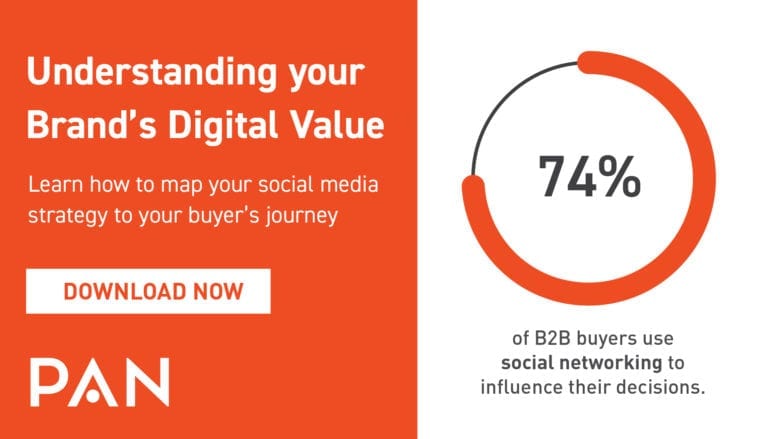In 2020, PAN launched its Issues Response Team (IRT), comprised of experts from our Media, Integrated Marketing, Creative and Content teams, to help our clients navigate sensitive issues with a holistic view of internal and external messaging. Below is our latest insights on navigating your brand on social when your company is being called out on its public channels.
As part of our IRT content series, we’ve talked about the pressure that 2020 put on companies to react to crises. Impossible to ignore is the large role that social media has played in necessitating companies to be part of conversations, and the urgency with which they must do so.
While social media platforms from Twitter to LinkedIn and even Instagram and Facebook provide a wonderful opportunity for companies to engage with key audiences and better communicate their brand and personality, crises require that companies develop a sound social media strategy for how they will/won’t engage in issues on their social channels. While every situation requires a custom approach, we’ve outlined some social scenarios you may be faced with and potential ways to problem solve them:
- A current or former employee participating in activity on social that is not in line with your company values
- A current or former employee making disparaging comments about the company, one of its executives or one of its practices
- A customer making disparaging comments on social
Let’s dive a bit further into what to do when the issue originates on social and someone is making disparaging comments about your brand.

Gather Key Stakeholders
It’s an anxiety-inducing feeling when you receive a notification that someone has commented negatively about your brand or one of your executives on social. Every time another “Like” or comment is added, the urgency only increases. Although it is tempting to quickly fire off a response (especially when the comment isn’t factual or, worse yet, a defamation of character), it’s more important to get the message right before taking action. And to do that, the first step is to make sure the right people have a seat the table to collectively determine the right next steps.
“Although it is tempting to quickly fire off a response, it’s more important to get the message right before taking action.”
Those parties might include representatives from the following teams:
- Legal, especially if the comment is in reference to a lawsuit
- Human Resources
- Customer Success, especially if the comment relates to a negative customer experience
- Marketing & Communications, including whoever handles internal/external comms and social
- Executive Team, in particular if a specific executive was called out
This group should first discuss the facts: What was said, by whom, on what channels and what has the response been to date?
Once the facts are on the table, this team can also dissect the comment: Is it factual? Does it have merit? Has the company or executive engaged with this person on this topic in the past? If so, was action taken at that time? Has legal been involved in this conversation?
This dissection will allow your team to discuss your communications strategy: How will you respond, who will respond, and furthermore, what do you want to say?
Take it Offline
Once you’ve gathered the right folks and have a clear picture of the scenario that the comment references, your gut instinct may be to respond in a manner that corrects a disparaging or untrue remark about your brand. Sometimes that correction is needed. However, this can often lead to a tit-for-tat conversation and could even further fuel the fire. While emotions can run high in these circumstances, additional mudslinging will not solve the problem.
Instead of responding publicly, wherever possible take your response to a Direct Message (DM), or even email if it is coming from a current or former employee. Lean into the option of a human-to-human response verses a response from the corporate brand handle wherever possible.
“Instead of responding publicly, wherever possible take your response to a Direct Message (DM), or even email if it is coming from a current or former employee. Lean into the option of a human-to-human response verses a response from the corporate brand handle wherever possible.”
At the end of the day, we are all humans and if someone is calling your company or one of your team members to the mat on social, they are looking to be heard. Engaging in a direct, offline conversation can allow the person to be heard and allow for a more thoughtful dialogue and response. Of course, if the comment is going “viral” or has gained a lot of steam, that may necessitate a broader response and more aggressive action, but the best first step is to try to resolve the issue offline.
Recommended Reading: Social Media Best Practices to Consider During Times of Crisis
Control What You Can Control
First and foremost, it is not a best practice to ask the commenter to take their post down, even if it is a current or former employee. Part of engaging in a social strategy means putting your company “out there.” That means preparing for the good and bad to be shared on social channels. It is also not recommended to delete the comment all together as that may indicate a lack of transparency (i.e., that you only show posts that are positive and delete those that are negative). After all, part of the reason you engaged in a social strategy to begin with is to build trust and engagement with your core audiences.
“First and foremost, it is not a best practice to ask the commenter to take their post down, even if it is a current or former employee. Part of engaging in a social strategy means putting your company “out there.” That means preparing for the good and bad to be shared on social channels.”
Although you can’t control the external dialogue, you can and should make sure that you are as prepared as possible to react in any way necessary over the next hours and days. This will involve creating necessary materials to communicate with key audiences who may have seen the exchange on social, even if you end up not needing them all! This process allows key stakeholders to be aligned and consistent in messaging.
Start by creating your key messages. These key messages should be direct and factual in nature and may weave in broader corporate values specific to the issue raised. These key messages should be woven into all of your internal and external communications, and you may choose to point back to public materials you have that support your response (company policies, mission and values, blog posts that dissect the issue surfaced, etc.).
From there, consider creating channel and audience specific materials such as:
- A holding statement to be posted from the corporate social handle. This is particularly important if the comment gained a lot of momentum or visibility.
- An FAQ about the issue. Again, this may never be distributed, but it allows your team to align around potential questions you may be asked and your answers to those questions.
- A communication to employees who may have seen the comment and where to direct inquiries.
- A communication to customers or partners who may have seen the comment.
- A communication to your Board of Directors.
It’s important to note when creating these materials that anything shared with any audience could be made public (for example, an internal communication could be shared externally), so special care should always be given to what is shared.
Establish a Monitoring Cadence
Equally as important as determining messaging is establishing a cadence for monitoring and communication. It is critical to keep an eye on the post and reach an agreement with key stakeholders on when, if at all, a certain level of engagement has risen to the scale of necessitating a public response. Hopefully, that step will not be necessary, and the issue can be resolved offline.
“Planning for hourly monitoring and reporting on the first day of the issue is critical and then you can determine the monitoring cadence for the days that follow.”
Planning for hourly monitoring and reporting on the first day of the issue is critical and then you can determine the monitoring cadence for the days that follow (morning, mid-day and end-of-day check-ins, for example). Report out to the key stakeholders on where the issue stands and if it’s under control or if it has escalated and requires the group to get back together. And, with any crisis, your team must be prepared to be fluid and nimble, as the situation evolves.
While these considerations are applicable to a social-specific scenario, we’re here to support no matter what the challenge or platform — stay tuned for more insights from PAN’s IRT in the months to come, and in the meantime, visit our resource center for more best practices!




